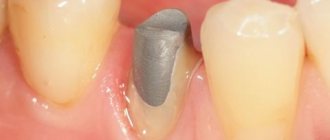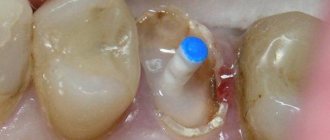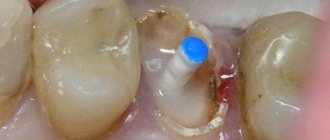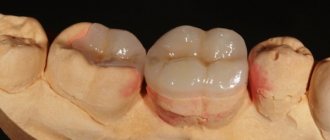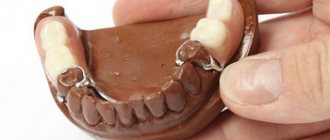Filling teeth with inlays
Sealing on the pin is performed according to the following scheme:
- Initially, the specialist diagnoses the damaged tooth using various methods. The most informative is dental radiography.
- Radiography provides comprehensive data on: the depth and shape of the canal, the location of the roots. This allows you to select the pin of the desired shape and thickness.
- Dental restoration makes no sense without a sanitation procedure. An initial examination and identification of foci of infection and carious lesions will help avoid premature destruction of the restored tooth. The doctor treats all cariogenic areas and stops foci of inflammation.
- Procedures for preparing root canals for implant installation. The specialist removes the pulp (if required), expands the canals and performs mechanical cleaning. After cleaning with the instrument, it is necessary to rinse the canals with an antiseptic solution.
- Installation of the pin with the selected fastener. A custom or factory-made pin is placed in the root canal, and the remains are removed using a specialized instrument. The canal cavity is filled with dental cement.
- After installing the pin, the specialist begins restoration of the coronal part of the tooth.
- The doctor applies the photopolymer composite layer by layer and polymerizes it with an ultraviolet lamp. This is how the size of the tooth is gradually formed.
Installation of pins for dental prosthetics
Installed pin
Preparations for the installation of pin structures should not be made on the day of the operation, but during a preliminary consultation. After the dentist has determined the feasibility and possibility of pin prosthetics, he must analyze in detail the condition of the tooth and study the thickness of its tissues. Taking into account all factors, the doctor selects the optimal materials and types of fastening.
If inflammatory processes and any other pathologies that may complicate the operation have been identified, they are treated.
After this, additional inspection is required. When the doctor is convinced that there are no contraindications, immediate preparation for prosthetics will begin.
The day before the installation of the pin, it is recommended to undergo a teeth cleaning procedure to remove stones and plaque. This will help minimize the number of bacteria that can get onto the wound surface after manipulation. You should not eat for six hours before the pin is inserted.
Procedure
First of all, an injection of anesthesia is injected into the gum to numb the area of work. After the anesthesia has taken effect and the doctor has checked the surface for susceptibility, installation work begins. The dentist prepares the root canal, removes nerves, cleans and, if necessary, widens the canal. The work area is treated with an antiseptic solution.
If a passive pin is used, the channel is pre-filled with a cementitious mixture, and the rod is immersed in it. The active pin is screwed into the channel, and the voids are filled with a polymer composition. For better fixation, the solution is dried with a halogen lamp.
Photo: how to place a pin in a tooth
When the rod is screwed in and securely fixed, a pre-made artificial tooth prosthesis is placed on it. Temporary cement is used for fixation; this is done in order to test the material for rejection. If the surrounding tissues of the oral cavity reacted normally to the foreign element, after a week the denture is placed on a permanent basis. If necessary, the doctor adjusts it using grinding. After installing the pin, the patient should not have the slightest discomfort,
the further outcome of treatment depends on strict adherence to the dentist’s recommendations.
Rehabilitation
The first time after installing the pin, you must strictly adhere to a number of restrictions and recommendations. Only the doctor who performed the treatment can say how long the rehabilitation period will last. For the entire period of rehabilitation you should:
- Eliminate from the diet hard and viscous foods that require active chewing movements. Food should be soft or even ground.
- On the first day you should not brush your teeth, only rinsing is acceptable. In the future, you will need to give preference to brushes with soft or medium bristles.
- Avoid foods and items that can damage the integrity of your teeth: nuts, seeds, toothpicks.
- Do not miss visits to the dentist and strictly follow individual recommendations.
Filling on a pin in different types of teeth
The advantages of the method lie in the integrity of the structure. If there are no moving or multi-layered parts, the structure appears more durable.
When installing a filling on a pin, there is no deformation or impact on the adjacent teeth in the row. Their enamel is not destroyed, the patient does not experience discomfort after the procedure.
The main disadvantages of the method include the formation of secondary caries. If the specialist used low-quality materials or paid little attention to the examination, then caries will form under the surface of the filling. The tooth is pigmented black, but the filling does not change.
A poor-quality filling in a tooth is clearly visible
Pin or implant: advantages and disadvantages
It is incorrect to talk about the advantages of one product over another, since pins and implants have different purposes. Therefore, we will talk about the pros and cons of pins and implants separately.
Pros of implants:
- complete tooth restoration;
- long service life (up to lifelong);
- artificial teeth look good (practically no different from natural teeth);
- there are no dietary restrictions (implants can withstand the load when consuming all types of food);
- low probability of rejection (less than 1% of cases).
Cons of implants:
- the need for surgical intervention;
- standard risks associated with surgery (for example, infection);
- long period of treatment (up to 2-5 months);
- high cost of dental implantation.
The main advantage of the pin is that it allows you to preserve the existing natural tooth for a long time. But there are other advantages of these products.
Advantages of pins:
- the product is easily placed at the root;
- relatively low cost of the pin;
- high aesthetic indicators;
- the ability to attach a fixed or removable prosthesis.
Disadvantages of pins:
- relatively short service life (most often it is 2-3 years - the time for which it is possible to save a decaying tooth);
- instability to significant loads on the chewing teeth (if the load is uneven, the root walls can be damaged);
- wedging effect (pins expand the boundaries of the tooth, which can damage surrounding tissues)2;
- there is a danger of developing allergic reactions;
- the likelihood of developing secondary caries increases;
- Metal pins can only be removed together with the tooth.
Installation of a tooth crown. Types of crowns and fixation methods
Dental crowns help restore the chewing function of the tooth and ensure full load. The method has a large number of indications for use:
- A strong tooth root, but a significant absence of the crown part. A pin is installed in the root, and an individual crown is fixed onto it.
- Strong enamel pigmentation that cannot be bleached. The indication may apply to several teeth at the same time.
- The presence of progressive non-carious dentin diseases.
- Abrasion of tooth enamel; destruction of enamel under the influence of exogenous or endogenous factors.
Differences between an implant and a post
First, let's understand the concepts:
- An implant is a rod (usually titanium) that is inserted (screwed) into the jawbone. Essentially, an implant (or implant) is an artificial tooth root. An abutment is then installed on it, and then a crown.
3d model of a dental implant
- A pin is a thin (compared to an implant) rod that is installed into the root of the tooth. These products are used to preserve natural roots and strengthen the crown part of the tooth (provided that it is preserved by at least 50%)1.
3d model of a dental pin
If implants are used when a tooth with a root is no longer there, then pins are used to save teeth that have not yet been lost (but need strengthening). The main condition for installing a pin is intact root canals.
The main differences between an implant and a pin are given in Table 1.
Table 1. Characteristics of pins and implants
| Parameter | Implant | Pin |
| Installation method | Implanted into the bone, imitating tooth roots | Placed in the root of the tooth |
| Purpose of the product | Tooth root replacement | Strengthening and preserving natural teeth |
| How long does it last | Several decades | The pin slows down tooth decay. Service life depends on the condition of the tooth |
| Additional treatment | Sometimes bone grafting is needed (if there is not enough bone tissue in the jaw) | It is necessary to remove the dental nerve and fill the canals |
| Treatment period | 2-5 months | Up to 1 month |
| Price | High | 3-7 times cheaper than implants |
Preparatory actions
Before installing a crown, the doctor must diagnose and sanitize the oral cavity. If there is cariogenic damage on the tooth for restoration, then the doctor carries out treatment.
Teeth crowns are simply placed on the base
The next preparatory stage is turning the tooth or installing a pin. If the coronal part is completely destroyed, but the root is strong, a stump tab is installed. The stump tab strengthens the canals and allows you to securely fasten the crown.
Advantages of extension with filling material
The tooth is built up with photopolymer material if caries has “eaten” less than 1/3 of the tissue. A small extended piece looks aesthetically pleasing and does not catch the eye.
Filling a large defect is also acceptable, but after 3-4 years the filling will have to be changed because it does not strengthen the crown of the tooth. If the cavity is large and a filling is placed in the tooth, it may crack and have to be pulled out. Therefore, a crown is a winning option in 4 out of 5 cases.
Types of dental crowns
Modern aesthetic dentistry offers a large number of materials for prosthetics; each patient will be able to choose a material according to their capabilities.
What is better: a pin or a crown on a tooth: features and differences.
Today, technology has advanced far forward, and with their help it is possible to restore a damaged or destroyed tooth and even grow a new one, much stronger and more beautiful than the previous one. There are two main procedures: installing a post or a crown. This article provides a description of the methods, their comparison and recommendations for selection.
A dental pin is a rod designed to strengthen a damaged or dilapidated tooth. The device is installed in the root zone or directly into the dentin, and a hardening mass is built up on top. The main function of the pin is to strengthen the entire tooth so that it does not break under load on the filling or the extended part.
There are two types of pins:
- Metal (titanium, brass, palladium, steel, gold (with impurities).
- Non-metallic (fiberglass, ceramics, carbon fiber).
The shape of the device is conical, cylindrical, cylindrical, screw.
According to the method of fixation, the pins are divided into:
- Active - a solid rod has a special thread with which it is screwed into the dental tissue. This type of pin is used to restore a completely or almost completely destroyed tooth, since when used, a strong load is created that can cause the tooth to split.
- Passive - the rod is fixed in the root canal using a special reinforcing material. This type is used to strengthen the tooth after treatment.
Indications for installation: half-destroyed or completely missing natural dental crown, creation of support when installing removable and fixed dentures.
Contraindications: diseases of the blood and nervous system, inflammatory pathologies of the oral cavity, caries, cysts in the oral cavity, root length is less than the planned crown height, root walls are too thin (less than 2 mm).
A crown is a dental prosthesis designed to strengthen a tooth, restore its previous shape and give an aesthetic appearance.
Crowns are not installed on the front teeth, only on the chewing ones. For the front teeth, there are veneers - thin plates made exactly to the shape of the teeth and installed on their front part.
Devices are made of ceramics (porcelain), metal, cermets, and plastics.
Crowns can be placed on a post, a damaged tooth, or an entire tooth (to give your smile a beautiful appearance and make it snow-white).
- Restoring the shape of a tooth destroyed as a result of injury, caries and other reasons.
- Restoration of chewing functions.
- Strengthening dentin.
- Whitening and improving the appearance of teeth.
Contraindications to applying a crown are age under 18 years, inflammatory diseases of the oral cavity, caries, too thin walls of the visible part of the tooth, chronic diseases in the acute stage, abnormal bite.
What is an implant
An implant (or implant) is a titanium rod that is screwed into the bone tissue in place of the lost tooth. It is shaped like a natural root. But this is not a finished tooth yet. To install a crown on an implant, you need a connecting link - an abutment. It is fixed to the implant, and a crown is already placed on it.
Most often, implants are made of titanium. This is a biocompatible material that practically does not cause rejection. For patients with metal allergies, zirconium dioxide implants are suitable.
All implants differ in size, shape and design features. A wide selection of models helps the doctor choose exactly the option that is suitable for your clinical case.
How is the implant installed?
Classic (two-stage) implantation lasts 5 – 6 months. First, the doctor installs the implant, and after 3–4 months he places the gum former. In another 2 - 3 weeks, after the gums have healed, an abutment and a crown will be placed. If implantation is performed in the smile area, then installation of a crown is possible immediately after surgery.
Sometimes an implant can be placed immediately after tooth extraction. This type of implantation is called one-stage implantation.
If a tooth has been missing for a long time, then an additional procedure may be necessary before implantation - bone tissue augmentation. The fact is that due to the lack of chewing load, the bone decreases, and it becomes insufficient for the implant to hold firmly and securely in the gum. In this case, another 3–4 months are required for engraftment.
